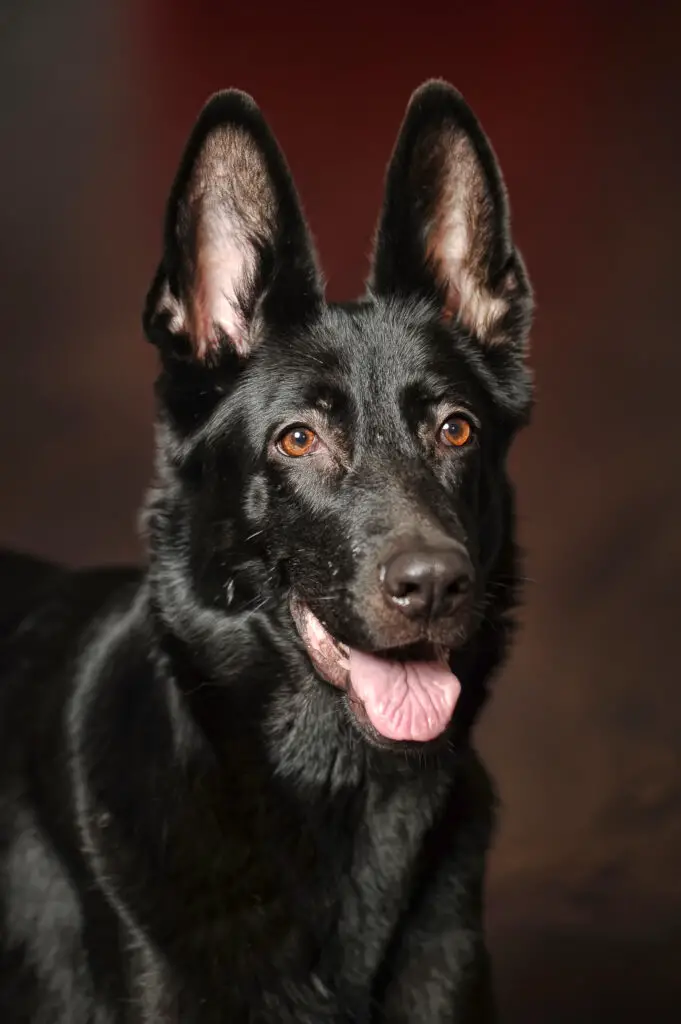History of the Black German Shepherd
Our website is supported by our users. We sometimes earn money when you click an affiliate link and make a purchase. This is at no extra cost to you and helps us to create quality content. Thank you so very much for your support.
The German Shepherd breed initially appeared in Germany towards the tail end of the 19th century, and they were first displayed in 1882 at a show in Hanover. Despite having a rough coat, a short tail, and resembling mongrels more than German Shepherds as we know them today, they were not like modern German Shepherds. After World War II, the German Shepherd Dog as we know it today began to take shape.
The first German Shepherd wasn’t born until 1899, when an ex-cavalry officer named Max Emil Friedrich von Stephanitz bought a dog named Horand von Grafrath. Honrand served as the principal poster dog for the Society for German Shepherd Dogs, which was later established.
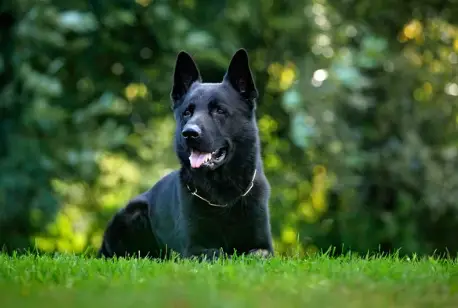
Honrand sired many litters and today, almost all German Shepherds are ancestors of his. The German Shepherd breed that exists today was created through extensive inbreeding. As was common practice, many of Honrad’s offspring were bred with each other.
That said, the breed standard was also developed through the cross-breeding of working sheep dogs from rural Germany. Stephanitz’s goal was to produce a highly energetic working dog for herding that could run for extended periods of time. Consequently, the German Shepherd became one of the most common dog breeds in the world in just a few generations.
The first breed show took place in 1899 following which the GSD became firmly established across Germany. In 1906 the first dogs were exported to the USA.
Since then, the breed has grown enormously in popularity and is now one of the most popular dog breeds for personal pets in the United states. Additionally, they are a favorite for home and business security and law enforcement because of their trainability and protective instincts.
The German Shepherd is one of several distinct breeds that emerged from the generic herding dogs of Europe by 1859. In the 1850s, efforts were made to standardize canine breeds and to promote characteristics like speed, strength, endurance, and intelligence that aided in sheep herding.
With industrialization and a reduction in farming, less dogs were needed for sheep herding.
Fortunately, by this time, humans were well aware of the canines’ stamina and trainability. And, due to their strength and intelligence, many people thought that German shepherds were the “ideal working dog.”
Since the breed’s creation, the Black German Shepherd has probably existed in some capacity. Many canines do not, however, possess the fully black gene. In the past, the condition probably led to the unaliving of many fully black German Shepherds. Despite being rare, the color is already reappearing.
Black German Shepherd: Physical Characteristics
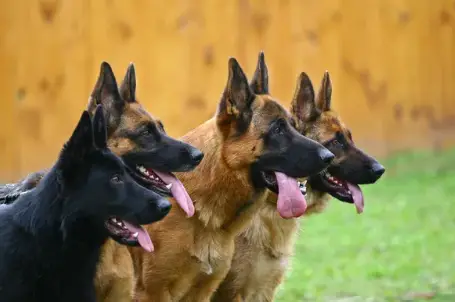
Black German Shepherd: Coat and Colors
Normal Black and Tan German Shepherds are fairly recognizable, however, they are commonly mistaken with the Belgian Malinois a.k.a. Belgian Shepherd. The Belgian Malinois is a completely different breed.
The Black German Shepherd dog has many of the same physical characteristics as regular German Shepherds and grow to have the same build and size as other color shepherds including the white German Shepherd.
What is not commonly known is that German Shepherds also come in color variations like white and black. Though the white and black German Shepherds are very rare, they are both recognized by the AKC to some capacity.
The German Shepherd breed, held the rank of #2 most popular dog in 2019, The #3 most popular dog in 2020 and #4 in 2021. Though it is slightly declining in popularity, it is still very high on the list.
The most common German Shepherd’s coat coloring is black and tan. However, they can come in Black, Black & Cream, Black & Red, Black & Silver, Blue, Gray, Liver, Sable and White.
However, when a black German Shepherd is born, it is not due to crossbreeding. The dog will be purebred with both parents carrying the rare black coat genes.
There is some controversy whether it is a recessive gene or a dominant gene that cause the solid black color.
Since a natural black German Shepherd with a solid black coat is so rare, they are very expensive and there are long waiting lists of people eager to purchase one.
German Shepherds can have one of three different coat types: Long-haired coat, Plush Coat or Double Coat. But make no mistake, black shepherds can still be purebred German Shepherds.

Black German Shepherds: Weight and Height
Males of this breed are usually heavier in weight but not in height and are considered to be large dogs.
A male black German Shepherd weighs between 65-100 pounds (29.5 kg-45 kg) and a female can range between 49-75 lbs (22kg-34kg).
Both sexes can range closely between 22-26 inches (56cm-66cm) in height.
Brown eyes are most common in this breed. Blue eyes may come about with a mixture with another breed that has blue eyes. So if you have purchased a dog that you believed to be purebred GSD and it has blue eyes, get a dog DNA test to determine whether this is true.
German Shepherds start out with floppy ears as puppies. Around 4-5 months old, their ears are normally erect. However, some puppies never grow out of the floppiness and if you prefer erect ears, they will need to be posted.
Posting, in this case, does not mean having the ear cut, it merely means that you will be supporting the upright position with the ear and making tape cuffs that surround the ear (and post or ear form with soft but rigid styrofoam-like a pool noodle) and are connected by more tape to each other at the top between the ears.
If you aren’t interested in an upright ear, floppy-eared GSDs are perfectly fine and perfectly adorable.
Black German Shepherd: Temperament

The black German shepherd has the same temperament as the rest of the colors. They were bred to be protective of sheep herds originally, hence the name, Shepherd. Because they are used for protection and police work, they are sometimes seen as aggressive or menacing. Again, since they have been bred for protection, they are usually trained to be aggressive towards threats to whomever or whatever they are protecting.
The are an active dog that is also very smart. So they need exercise and stimulation to keep them healthy. Additionally, as protection dogs, they are prone to excessive barking. Check out our article on Do Dogs Get Tired of Barking to see how you can curb this behavior if you are lucky to get one that is very vocal.
Barking can be caused by anxiety and according to our head writer, Michelle Lehr, as quoted in Discover Magazine,
“You should make sure your dog feels like they have a safe place to go that limits disruptive noise and chaos. Talk to your veterinarian about medications as well as alternative treatments like CBD, acupuncture and even pet massage.”
Also, as intelligent dogs, they are very easy to train but need to be socialized at a young age or they can become too protective of their family.
We had a mixed breed dog of half German Shepherd and Norwegian Elkhound named Bear. We lived on a farm in the country so he wasn’t socialized to people and dogs.
A neighbor was visiting and my dad was giving him instructions on how to take care of Bear while we were on vacation. We were standing in the perimeter of Bear’s dog house. Unknowing to what was about to happen, I stepped behind the neighbor to go around him and Bear went into attack mode and tore the entire front of the neighbor’s coveralls off. We were both shaken but it was a good lesson in the protectiveness of an unsocialized GSD, even diluted with another breed.
P.S. The neighbor was fine and forgave our dog.
Black German Shepherd: Training and Exercise
As previously said, GSDs are rather simple to train because of their intelligence. On the plus side, they typically don’t have stubbornness issues and will obey instructions.
These beautiful dogs do, however, require training. Without it, they could become extremely protective and even dangerous.
However, since they are so simple to teach, meeting this need is relatively simple. We do advise enrolling puppies in puppy lessons as early as possible. These sessions enable you to jump-start your dog’s training while also giving them the extra socializing they require.
We advise enrolling in private lessons with an expert trainer if you adopt an older German Shepherd that appears to need socializing. Your dog can be trained in a few fundamental commands before being socialized with other dogs and people who aren’t a threat. Your trainer ought to be able to assist you in this.
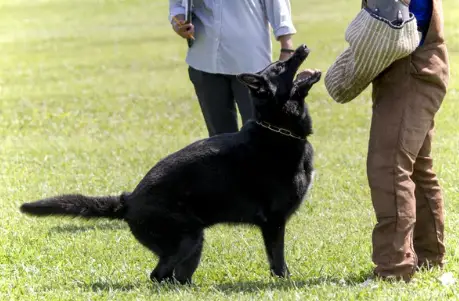
They respond well to positive reinforcement.
Completely black German Shepherds are no different from other members of the breed in that they are more energetic. Although there are dog breeds that are more energetic, these dogs are the ideal for people who are highly active. For an adult dog, minimum of two medium-to-long walks each day are required.
Puppies will probably require some additional playtime as well. However, before your puppy is three months old, it is advisable not to over-exercise your Black German Shepherd puppy with long walks or runs.
Related Articles:
Common Health Issues for the Black German Shepherd
As far as purebred dogs go, German Shepherds are generally in good health. They are vulnerable to various health issues, though. Many of these are the result of early inbreeding in the breed, which increased the prevalence of some previously rare traits.
There is no evidence that black German Shepherds are more susceptible to health issues than their black-and-tan relatives. Their coat color is unrelated to any specific health conditions or anything of the type.
It is crucial to get these puppies from a reputable breeder because they prefer to subject every dog they intend to breed to a number of health tests. This enables them to identify health issues and select only the healthiest dogs for breeding. Via this meticulous breeding, many health issues can be lessened or avoided, but you’ll probably need to go through a breeder to obtain it.
It is advisable, that when you decide to adopt your German Shepherd that it wasn’t bred as a show dog but as a working or pet-grade dog instead. Due to the extremely different goals for which they were bred, these two dog lines are somewhat different from one another. Show dogs frequently conform to the breed standard to an extraordinary degree, which increases the number of health issues they experience.
Working or pet-grade dogs, on the other hand, were bred with utility and functionality in mind and are sturdier and usually healthier.
Black German Shepherds enjoy the same level of health as black and tan German Shepherds.
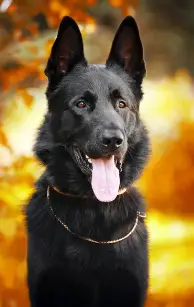
Hip and Elbow Dysplasia
Hip and elbow dysplasia are common in German Shepherds. This condition develops when the joint’s ball and socket do not line up properly, causing excessive wear and tear. This eventually results in symptoms resembling arthritis, but much sooner than is expected for arthritis.
The dog usually sustains this harm while it is still a puppy and growing, although it is possible that it won’t manifest itself until a few years later.
There are a few things pet owners may take to lessen the likelihood that their German Shepherd will develop hip and elbow dysplasia. As a result of the dog’s increased calorie intake during the puppy stage, the hip joint may start to expand at an unusual rate, which is a proven cause of hip dysplasia. So avoid overfeeding your puppy.
As a puppy is in training, you can use treats but make them as small as possible or alternately feed them less during meal times. In other words, balance out their calories.
Over exercising your puppy can cause early hip dysplasia in adulthood.
According to the Institute of Canine Biology:
“Puppies raised on slippery surfaces or with access to stairs when they are less than 3 months old have a higher risk of hip dysplasia,while those who are allowed off-lead exercise on soft, uneven ground (such as in a park) have a lower risk.”
Canine Degenerative Lumbar Stenosis
Canine Degenerative Lumbar Stenosis is a very painful neurologic dysfunction caused by compression of the spinal nerves between a bulging disc and the thickening of the joint capsule.
According to nih.gov it most commonly occurs in medium to large breed dogs. And the German Shepherd is pre-disposed to having it.
One of the easiest ways to avoid and/or reduce CDLS is to make sure your Black German Shepherd maintains a healthy weight. Low impact exercise and play are also good for keeping your dog moving. The less your dog moves, the worse the pain will be.
Treatment in the form of surgery or injected steroids can be used in extreme cases.
Chronic Degenerative Radiculomyelopathy (CDRM)
A.K.A. Degenerative Myelopathy (DM) is the deterioration of the white matter of your dog’s spinal cord and is similar to ALS or Lou Gehrig’s disease in humans.
In the beginning it looks like arthritis, however, as it progresses to leg weakness which results in wobbling or stumbling.
Also what to watch for in the beginning, according to VCA Animal Hospitals:
Early clinical signs include:
· The hind paws “knuckle” or turn under so that the dog walks on its knuckles, especially when turning.
· The dog’s hindquarters appear to sway when standing still.
· The dog falls over easily when pushed from the side.
· The hind feet seem to scrape the ground when walking and sometimes the top surface of the feet become hairless and irritated from repeated trauma.
· The dog has difficulty getting up from a lying position.
As the condition progresses and the spinal cord deteriorates, these symptoms worsen, eventually progressing to paralysis of the hind end.
German Shepherds have degenerative myelopathy frequently enough to suggest a susceptibility. To determine a dog’s propensity for degenerative myelopathy, a DNA test is available. Due to the high cost of this test, many breeders both test their dogs before breeding and their puppies just after birth.

von Willebrand disease
Additionally, German Shepherds have a higher incidence of von Willebrand disease (VWD) than the general dog population. They probably have a genetic susceptibility to it.
VWD, similar to but not exactly, will look a lot like hemophilia does in humans. It is the inability of your dog’s blood to clot when injured.
If your dog is injured, and the bleeding won’t stop, even if small clots are forming, go to your vet or nearest emergency clinic. They will be able to treat your dog with a transfusion to increase the ability of your dog’s blood to clot.
Exocrine Pancreatic Insufficiency
Is the inability of your dog’s pancreas to create the enzymes to digest fats, carbohydrates and proteins.
If your dog starts to lose weight inexplicably despite eating normal portions and yet is still excessively hungry or you see that your dog’s feces has turned pale and fatty, they may be suffering from Exocrine Pancreatic Insufficiency (EPI).
Blood and fecal samples can be used to determine whether your dog has EPI. Luckily it is treatable and dietary changes, pancreatic supplements and prescription medicine are typically used to combat this problem.
The good news is that German Shepherds really have lower ear infection rates than other breeds of dogs. Their high and open ears are excellent for air circulation and this keeps bacteria loving moisture away. Additionally, they produce excessive amounts of cerumen (a.k.a earwax), which is also an inhospitable environment for bacteria.
This does not mean that their ears do not need to be cleaned regularly though. And this leads to the next topic of grooming.
Related Articles:
Grooming a Black German Shepherd
All German Shepherds are considered to be double-coated, meaning they have a short under layer of soft fur for insulation and usually a harsher layer top coat called the guard coat.
There are exceptions to this as in a silky coated Pomeranian will have a super fine and soft undercoat and the top layer is very soft and silky, it’s merely longer that the bottom coat. But generally, the first definition of this is true.
Some black German Shepherds will be considered to have a single coat (smooth coat) but they still actually have a double coat. This is especially true for show dogs, where in the ring they are knows as “Smoothies.”

The length of coat your black German Shepherd has will determine how much grooming is necessary. Only two to three times a week will be sufficient for brushing medium-coated dogs. This cleans the dog’s coat of dirt and dust and helps avoid tangles.
To avoid matting, longer coats should be combed at least once a day. Otherwise, the fur of your dog will get unnecessarily matted and may require assistance from a professional groomer.
Unchecked mats can be extremely painful and can cause irritation to your dog’s skin.
Furthermore, if your double-coated GSD needs to be shaved, this can lead to other skin and hair health problems. The undercoat hair can regrow more quickly after being shaved to the skin, and occasionally it will supplant the slower-growing guard hairs. A type of alopecia may result from shaving off a double coat because it damages the hair follicles. This could result in bald areas, long-term hair loss, or a change in the coat’s texture.
In addition, double-coated dogs have the ability to control their own body temperature. They are actually hotter after shaving because the coat helps to keep the heat out. They are now more susceptible to hypothermia, a potentially catastrophic dip in body temperature, or heatstroke.
And finally, When you shave your dog, you are essentially exposing the unprepared skin to the sun and heat. Without their protective natural coat, their delicate skin is vulnerable. If their skin is exposed, they risk getting a sunburn or heatstroke.
If you cannot handle a lot of excess hair, do not get a black German Shepherd or any other double-coated dog because not only do they shed a bit throughout the year, they have a “seasonal shed” a couple of times a year.
Though it is supposed to happen in the spring and the fall, we had a dog that shed her coat in January and July. So it may not be corresponding to seasons as much as it could have been hormones. As menstruation, pregnancy and/or thyroid issues can also cause your dog to shed.
There are shampoos that will help to release your dog’s undercoat during seasonal sheds. However, with that said, you will still want to invest in good brushes for you dog and your home.
We checked around with some groomers and of the shampoos readily available to the public, the one that was most recommended happened to be a popular choice with good reviews on Amazon. The Coat Handler Undercoat Control deShedding Dog Shampoo is has Omega 3 & 6, as well as Vitamin E. It is really good if your dog has dry skin, which will be especially helpful if your dog is a senior GSD.
If you have more than one dog, there is a much larger bottle available.
A good deshedding tool is this Dematting Undercoat Rake because of the rounded tines, it is able to “scoop” under the top coat of your dogs fur and gently pull out the soft undercoat, which is where most of matting occurs during a shed. It’s more comfortable than a slicker brush which can be a bit irritating if your dog has sensitive skin.
If your dog’s skin is normal and you are determined to use a slicker brush, we recommend the Hertzko Self-Cleaning Slicker Brush because the bristles are retractable, the fur comes right off. Otherwise, if you use a regular slicker brush, the fur is almost impossible to remove completely and you end up with a mess like this.
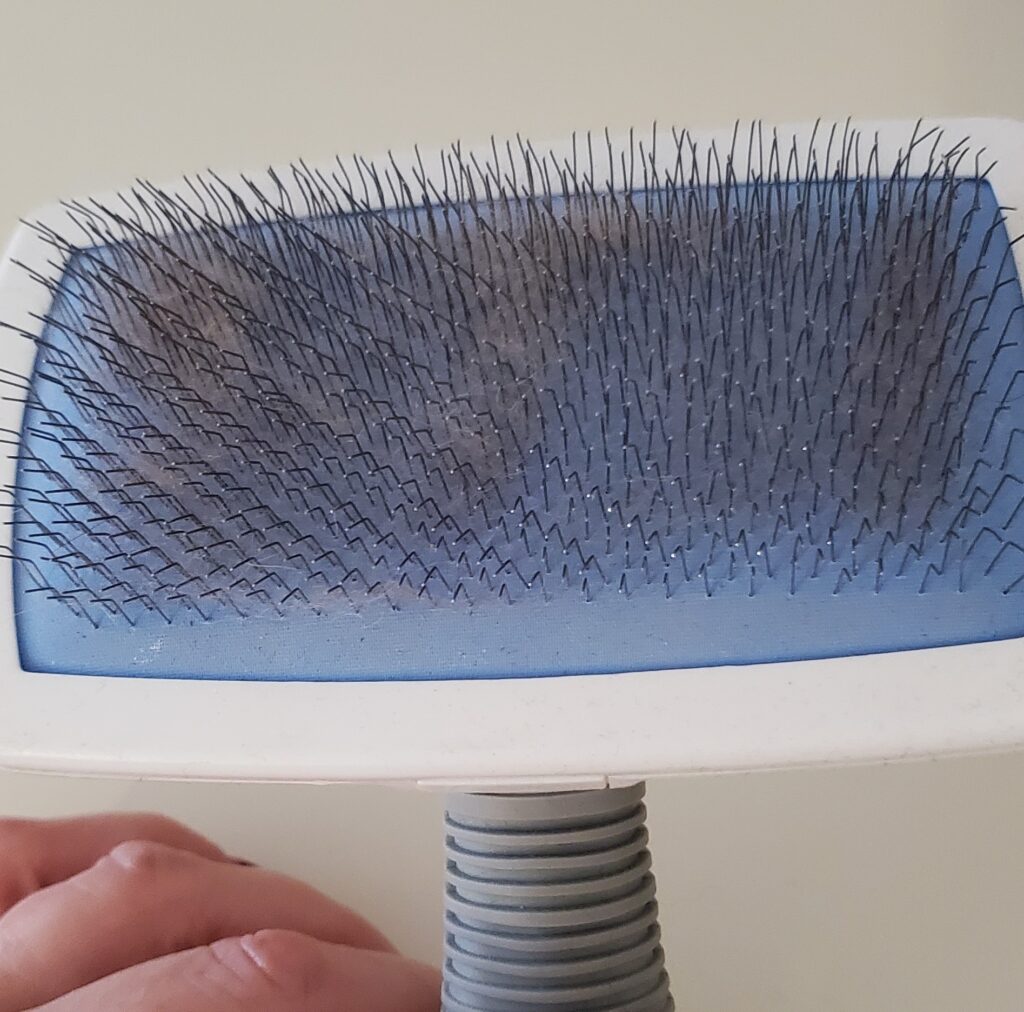
Adopting and Owning a Black German Shepherd
Since German Shepherds are so popular in the United States. Typically, it is not too difficult to locate a German Shepherd breeder in your area. But not all breeders can produce the black variety. Therefore, finding a breeder who specializes in black German Shepherd puppies is necessary.
You can anticipate that a solid black German Shepherd won’t be frequently available because they are significantly rarer than the other shades. Since breeders won’t know if puppies will be born black and conscientious breeders won’t overbreed their dogs, fewer black German Shepherd puppies are born.
These black dogs, as can be expected, due to their rarity, they will typically cost substantially more than a black-and-tan German Shepherd.
A black German Shepherd is in high demand, therefore you frequently have to be willing to spend a little bit more. And it is common to be on a long waiting list. If you aren’t picky on pedigree, you may try your local shelters and let them know you are on the lookout for a black GSD.
A premium, all black puppy will cost you between $800 and $2,000 on average. This is far more than the $500 to $1,500 you might anticipate paying for a standard German Shepherd. Being a common breed, they are typically less expensive than some other rare dogs.
In contrast, the price of a Labrador Retriever is between $800-1200. A Siberian Husky will run $400-$1200 and a French Bulldog ranges from $1500-3000.
Although backyard breeders may nurture their dogs indoors, many are unaware of suitable socialization techniques. While some breeders will go out of their way to invite guests and let kids play with the puppies, most backyard breeders don’t.
It is advisable to adopt puppies from skilled breeders. Otherwise, you risk getting a puppy with a bad disposition and little socialization.
Related Posts:
Always inquire about the parents’ ancestry as well as the breeder’s health examinations. Asking for the parent’s CHIC numbers (Canine Health Information Center) will enable you to independently check on their health testing online. A dog has not been registered and subjected to a health examination if they lack a CHIC number. If your dog has been registered with the AKC, this number should be on their paperwork.
These dogs are only suggested for experienced and knowledgeable dog owners. Ideally, you should have previously owned at least one dog. It is advised that you also have some prior experience with more spirited and energetic canines.
The black shepherd a propensity for high energy and are highly active. They can easily turn destructive if they don’t get enough exercise. In actuality, a German Shepherd’s destructive conduct is mostly brought on by boredom. Puzzle games and exercise activities are advisable.
The game designed by Nina Ottosson by Outward Hound MultiPuzzle Interactive Dog Treat Puzzle is a is difficult enough for your dog to stay entertained for quite a while, but not get bored or frustrated.
Black German Shepherds also require substantial training, thus it is better if their handler has previous dog-training experience. You don’t necessarily need to be an expert to train them because they are pretty simple.
We firmly advise giving the amount of effort that Black German Shepherds demand some serious thought if you’re thinking about getting one. As puppies, they will occupy a few hours each day and need up to an hour or more of activity every day. These dogs are not suitable for casual dog owners.
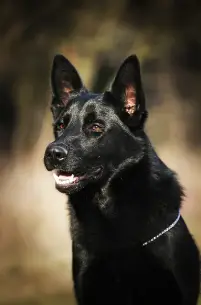
FAQs on The Black German Shepherd
Are black German Shepherds healthier?
There is no evidence that black German Shepherds are more susceptible to health issues than their black-and-tan relatives. Their coat color is unrelated to any specific health conditions.
What are black German Shepherds called?
The German Shepherd and the Black German Shepherd are the same breed. The Black German Shepherd is occasionally mistaken for being a distinct breed from the German Shepherd but it’s just a fully black version of the original.
Is a black German Shepherd rare?
The rare and highly coveted black German shepherd dog breed is a variation of the common German shepherd canine breed. Although there are other GSD color variations, black German shepherd puppies are among the most well-liked due to their elegant, attractive coats.
The Bottom Line on the Black German Shepherd
While many people confuse the black and tan dogs with the Belgian Malinois, they are a completely separate breed.
Black GSDs are completely purebred German Shepherds, despite their rare coloration. Many of these canines are more expensive than their black-and-tan counterparts.
The American Kennel Club does recognize the black German Shepherd as an official coloration. However, you still don’t see many of these dogs because they are so rare. It will often take you a little bit before you locate a completely black puppy, so be patient and be prepared to wait.
Despite their unusual colorations, these dogs are very similar in size and shape as to all other German Shepherds. They have the same temperament and work great as guard dogs and police dogs.
However, you have to prepare to train and socialize them properly. They require quite a bit more work than other breeds in the beginning, but it is absolutely worth it in the end. German Shepherds are not for the casual dog owner. They need someone who can commit time to their training and activity needs.
Please read our Legal Disclaimer

